Royal Aircraft Factory B.E.2 Video - Picture
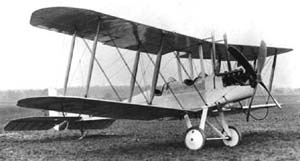
|
|
Royal Aircraft Factory B.E.2
B.E.2c

Role: Reconnaissance
Manufacturer: Royal Aircraft Factory, Vickers, Bristol
First flight: February 1912
Introduced: August 1914
Primary user: Royal Flying Corps
Number built: ~ 3,500
Variants: B.E.9, B.E.12
The Royal Aircraft Factory B.E.2 (Blériot Experimental) was a British single-engine two-seat biplane in service with the Royal Flying Corps (RFC) during World War I. About 3,500 were built, used as fighters, interceptors, light bombers, trainers and reconnaissance aircraft.
A B.E.2a of No.2 Squadron RFC was the first aircraft of the Royal Flying Corps to arrive in France after the start of the First World War, on 26 August 1914.
Development
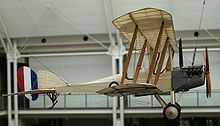
Picture - A B.E.2c at the Imperial War Museum in London.
The B.E.2 was designed by Geoffrey de Havilland as a development of the B.E.1, with a 60 hp (45 kW) air-cooled Renault V-8 engine replacing the water-cooled Wolseley of the earlier aircraft. It first flew on 1 February 1912 with de Havilland as the test pilot. On 12 August 1912 it set a British altitude record of 10,560 ft (3,219 m). It started production as a reconnaissance machine, and two years later formed part of the equipment of three squadrons - squadrons equipped with a single type of aeroplane were still to come. These were all sent to France shortly after the outbreak of war. The early B.E.2a and b aircraft were replaced during 1915 by the B.E.2c, so extensively modified as to be virtually a new type, based on research by Edward Teshmaker Busk to develop an inherently stable aeroplane. The c began to be superseded by the final version, the B.E.2e, nicknamed the "Quirk", in 1916.
Well into 1917 the last front-line B.E.2e was withdrawn, long after the type was obsolete. It continued in service throughout the war as a home defence fighter, in which role it was for a time a surprising success, and as a trainer.
Some 3,500 B.E.2s were built by over 20 different manufacturers: an exact breakdown between the different models has never been produced, although the B.E.2c was almost certainly the most numerous.
The B.E.9 and the B.E.12 were variants designed to give the B.E.2 an effective forward-firing armament - the B.E.12 (a single seater) went into production and squadron service, but was not a great success.
Faults of the type
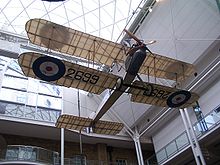
Picture - Imperial War Museum example from underneath

Picture - Leutnant Kurt Wintgens' "E.5/15" Eindecker, the first fighter aircraft in history to use a synchronized machine gun to down an opposing aircraft
The B.E.2 has always had a very bad press, and had become an unpopular aircraft by 1916.
By this time it had at least three serious weaknesses as a warplane. The first was that its small air-cooled inline motor made it seriously underpowered, and was unreliable even by the standards of the time. When bombs were to be carried or maximum endurance was required, the observer and his gun had to be left behind. Although the B.E.2 had a reasonable performance for 1914/15 it remained in service long after much more powerful aircraft had become available to the enemy.
The second weakness stemmed from this. As it was often flown as a single-seater, it was necessary to have the observer's cockpit over the centre of gravity, in front of the pilot. In this awkward position, he was hampered by the struts and wires supporting the centre section of the top wing (see illustration), and at best had to shoot back over his pilot's head.
The third weakness is more controversial. In 1912 and following years there was a good deal of controversy about two competing aircraft design philosophies. One, typified by the Wright Brothers, said that an aeroplane should be inherently unstable, and that deviations from straight and level flight should be corrected by the pilot. Aircraft designed on this principle tended to be agile, but required constant vigilance and attention and a fair degree of skill from the pilot. The opposing philosophy strove towards an aircraft that, while it could be steered, largely kept itself steady in the air, and diverged from straight and level flight only when its pilot wanted it to. This tendency naturally worked against desired changes in flight attitude as well as involuntary ones, and reduced manoeuverability. Since the standard of pilot training was so poor in the RFC a stable aircraft had real advantages, but it did make it difficult to escape a more aerobatic enemy, even if pilot skills had permitted it. There is however a good deal of evidence in contemporary accounts that suggests that the B.E.2 was less stable and more manoeuverable than it was supposed to have been.
The essential vulnerability of the B.E.2 became plain in late 1915, with the advent of the first German fighters. This led the British press to dub it "Fokker Fodder", while German pilots nicknamed it kaltes Fleisch ("cold meat"). British ace Albert Ball summed it up as "a bloody awful aeroplane". Unable to cope with such a primitive fighter as the Fokker E.I, it was virtually helpless against the newer German fighters of 1916-17. The aircraft's poor performance against the Fokker Eindecker and the failure to improve the aircraft or replace it caused great controversy in England, with Noel Pemberton Billing attacking the B.E.2 and the Royal Aircraft Factory in the House of Commons on 21 March 1916, saying that RFC pilots in France were being "rather murdered than killed". This prompted the setting up of a judicial enquiry, which eventually cleared the factory.
In fact, once the threat from the Fokker monoplanes was contained by the availability of allied fighters such as the Airco D.H.2, Nieuport 11 and Royal Aircraft Factory F.E.2, B.E.2c losses over the Western Front dropped to an acceptable level, with official records indicating that in the second quarter of 1916, the B.E.2 actually had the lowest loss rates of all the major types then in use. Encouraged by this, the RFC took delivery of large numbers of the BE.2e, which promised improved performance. By the Spring of 1917, however, conditions on the Western Front had changed again, with the German fighter squadrons re-equipped with better fighters such as the Albatros D.III. Although it had been planned to replace the B.E.2 in front-line service by this time with the Armstrong Whitworth F.K.8 and Royal Aircraft Factory R.E.8, deliveries of these types was slower than hoped. This culminated in what became known as "Bloody April", with the RFC losing 60 B.E.2s during that month.
An incident illustrating both the poor level of piloting skills with which new RFC pilots were sent to France in 1917 and the level of popularity of the B.E.2e on the Western Front is recorded by Arthur Gould Lee, then a young RFC novice, in his book No Parachute. On 19 May 1917 six pilots newly arrived in France and, still to be allocated to a squadron, were each given a new B.E.2e to ferry between RFC depots at St Omer and Candas. One crashed in transit, three crashed on landing and one went missing (the pilot was killed). Lee, the pilot of the only aircraft to arrive safely, wrote in a letter to his wife:
I felt rather a cad not crashing too because everyone is glad to see death-traps like Quirks written off, especially new ones.
Fortunately the B.E.2e was by this time already being rapidly replaced on the Western Front by the R.E.8 and Armstrong Whitworth F.K.8, but for far too many young airmen this was more than a year too late.
Other fronts
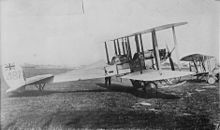
Picture - A German Captured B.E.2
From 1917 onwards, the B.E.2 was mostly withdrawn from the front line but continued in use for submarine spotting and as a trainer. Before this it had already been the first effective night fighter.
As early as 1915 the B.E.2c had been used in attempts to intercept and destroy the German "Zeppelin" airship raiders. The "interceptor" version of the B.E.2c was flown as a single-seater with an auxiliary fuel tank on the centre of gravity, in the position of the observer's seat in the reconnaissance version. After an initial lack of success while using darts and small incendiary bombs to attack airships from above, a Lewis gun was mounted to fire incendiary ammunition upwards, at an angle of 45°. The tactic proposed was to attack the airship from below, in a similar manner to that later employed by German night fighters in World War II (Schrx¤ge Musik). This proved very effective.
The first successful attack took place on the night of 3 September 1916, when a B.E.2c flown by Captain William Leefe Robinson downed the first German airship to be shot down over Britain, winning him a Victoria Cross and cash prizes totalling £3,500 that had been put up by a number of individuals for the first Zeppelin kill over the British Isles.
This was not an isolated victory: five more German airships were destroyed by Home Defence B.E.2c interceptors between October and December 1916.
The performance of the B.E.2 was inadequate to intercept the aeroplane raiders of 1917/18, and it was replaced by later types of night fighter, using techniques pioneered by the B.E.2c.
Thereafter the surviving B.E.2s (mainly B.E.2es) were used as trainers. In spite of the type's stability it was capable of comprehensive (if somewhat stately) aerobatics, and was by no means as bad a trainer as might have been expected.
Survivors
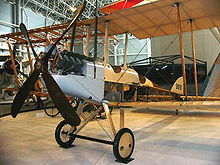
Picture - B.E.2c in the Canada Aviation and Space Museum.
Aircraft and replicas are preserved at several museums, including the Imperial War Museum, Duxford; the RAF Museum, Hendon; the Canada Aviation Museum, Ottawa; the Musée de l'Air et de L'Espace, Paris; the Militaire Luchtvaartmuseum, Soesterberg, Netherlands; and the Norwegian Armed Forces Aircraft Collection at Oslo Airport, Gardermoen, Norway.
B.E.2f serial A1325 has been restored to airworthiness by The Vintage Aviator Ltd in New Zealand, with a B.E.2f reproduction and two reproduction B.E.2cs also well underway by the same firm. The B.E.2f restoration utilises an original RAF1A V8 powerplant, and made its debut at the Classic Fighters Omaka airshow in April, 2009.
The UK's latest replica was built at Boscombe Down, Wilts, and completed around 2008.
Variants
B.E.1: Prototype - important pioneer tractor biplane
B.E.5: Prototype, officially a rebuild of a Howard Wright biplane, powered by 60 hp (45 kW) ENV engine, otherwise similar to original B.E.2. First flight 27 June 1912. Rebuilt with Renault engine and effectively became B.E.2.
B.E.6: Prototype, officially a rebuild of the Royal Aircraft Factory S.E.1. First flown 5 September 1912, powered by a 60 hp (45 kW) ENV engine like the B.E.5, but refitted with Renault before delivery to RFC later that month.
B.E.2a: Initial production version of B.E.2. Built in small numbers from late 1912 - still a standard type at the outbreak of war in late 1914
B.E.2b: basically the same as the "a" with higher sides to the cockpits; late examples used ailerons instead of wing warping
B.E.2c: extensively redesigned - really a new aeroplane. The most produced version 1914-1916
B.E.2d: essentially a "c" variant with a larger gravity fuel tank
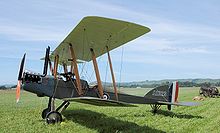
Picture - B.E.2f A1325 at Masterton, New Zealand, 2009
B.E.2e: the final version, with new wings. Expected to be a great improvement on the "c", it was a major disappointment. Nicknamed the "Quirk".
B.E.2f: B.E.2c with B.E.2e wings.
B.E.2g: B.E.2d with B.E.2e wings.
B.E.9: B.E.2c with a wooden box (called a "pulpit") in front of the propeller for an observer/gunner's seat. It remained a prototype only.
B.E.12: single-seat B.E.2 with a synchonised gun and more powerful engine.
Operators
Australia
Australian Flying Corps
No. 1 Squadron AFC, in Egypt and Palestine.
No. 3 Squadron AFC, in France.
No. 4 Squadron AFC, training.
No. 7 (Training) Squadron AFC, in the United Kingdom.
Mesopotamian Half Flight
Central Flying School AFC, at Point Cook, Victoria.
Belgium Estonia
Estonian Air Force
Netherlands
One aircraft only.
Norway
Norwegian Army Air Service
South Africa
Union Defence Force / South African Air Force
Serial numbers A3109 and A3110 build by the Wolseley Motor Company and nicknamed Rio de Janeiro Britons Nos. 1 & 2 were two of the first aircraft used by the South African Air Force United Kingdom
Royal Flying Corps / Royal Air Force
No. 2 Squadron RAF
No. 3 Squadron RAF
No. 4 Squadron RAF
No. 5 Squadron RAF
No. 6 Squadron RAF
No. 7 Squadron RAF
No. 8 Squadron RAF
No. 9 Squadron RAF
No. 10 Squadron RAF
No. 12 Squadron RAF
No. 13 Squadron RAF
No. 14 Squadron RAF
No. 15 Squadron RAF
No. 16 Squadron RAF
No. 17 Squadron RAF
No. 19 Squadron RAF
No. 21 Squadron RAF
No. 22 Squadron RAF
No. 23 Squadron RAF
No. 24 Squadron RAF
No. 25 Squadron RAF
No. 26 Squadron RAF
No. 28 Squadron RAF
No. 29 Squadron RAF
No. 30 Squadron RAF
No. 31 Squadron RAF
No. 33 Squadron RAF
No. 34 Squadron RAF
No. 36 Squadron RAF
No. 37 Squadron RAF
No. 38 Squadron RAF
No. 39 Squadron RAF
No. 42 Squadron RAF
No. 43 Squadron RAF
No. 46 Squadron RAF
No. 47 Squadron RAF
No. 49 Squadron RAF
No. 50 Squadron RAF
No. 51 Squadron RAF
No. 52 Squadron RAF
No. 53 Squadron RAF
No. 54 Squadron RAF
No. 55 Squadron RAF
No. 57 Squadron RAF
No. 58 Squadron RAF
No. 62 Squadron RAF
No. 63 Squadron RAF
No. 66 Squadron RAF
No. 67 Squadron RAF
No. 75 Squadron RAF
No. 76 Squadron RAF
No. 77 Squadron RAF
No. 78 Squadron RAF
No. 82 Squadron RAF
No. 91 Squadron RAF
No. 96 Squadron RAF
No. 98 Squadron RAF
No. 99 Squadron RAF
No. 100 Squadron RAF
No. 105 Squadron RAF
No. 110 Squadron RAF
No. 113 Squadron RAF
No. 114 Squadron RAF
No. 141 Squadron RAF
No. 142 Squadron RAF
No. 144 Squadron RAF
No. 187 Squadron RAF
No. 189 Squadron RAF
No. 190 Squadron RAF
No. 191 Squadron RAF
No. 269 Squadron RAF
No. 273 Squadron RAF
Royal Naval Air Service
United States
American Expeditionary Force
Specifications (B.E.2c - RAF 1a engine)
Data from British Aeroplanes 1914-18
General characteristics
Crew: Two, pilot and observer
Length: 27 ft 3 in (8.31 m)
Wingspan: 37 ft 0 in (11.28 m)
Height: 11 ft 1½ in (3.39 m)
Wing area: 371 ft² (34.8 m²)
Empty weight: 1,370 lb (623 kg)
Loaded weight: 2,350 lb (1,068 kg)
Powerplant: 1x— RAF 1a air cooled V-8 engine, 90 hp (67 kW)
Performance
Maximum speed: 72 mph (63 knots, 116 km/h) at 6,500 ft (1,980 m)
Endurance: 3 hr 15 min
Service ceiling: 10,000 ft (3,050 m)
Climb to 3,500 ft (1,070 m): 6 min 30 s
Climb to 10,000 ft (3,050 m): 45 min 15 s
Armament
Guns: Normally 1 x— .303 in (7.7 mm) Lewis gun for observer
Bombs: 224 lb (100 kg) of bombs
(With full bomb load usually flown as a single-seater, without machine gun)
Related development
B.E.12
Comparable aircraft
Aviatik B.I
Albatros B.I
LVG B.I
Bibliography
Bruce, J.M. British Aeroplanes 1914-18. London:Putnam, 1957.
Bruce, J.M. "The B.E.2 Series: Historic Military Aircraft No.7, Part 1". Flight, 2 April 1954, pp. 393-397.
Bruce, J.M. "The B.E.2 Series: Historic Military Aircraft No.7,Part 2". Flight, 16 April 1954, pp. 478-482.
Bruce J.M. The Aeroplanes of the Royal Flying Corps (Military Wing). London:Putnam, 1982. ISBN 0 370 30084 x.
Cheesman, E.F. (ed.). Reconnaissance & Bomber Aircraft of the 1914-1918 War. Letchworth: Harleyford, 1962.
Gerdessen, Frits. "Estonian Air Power 1918-1945". Air Enthusiast No. 18, April-July 1982, pp. 61-76. ISSN 0143-5450.
Hare, Paul R. The Royal Aircraft Factory. London:Putnam, 1990. ISBN 0-85177-843-7.
Munson, Kenneth. Bombers, Patrol and Reconnaissance Aircraft 1914-1919. London: Blandford, 1968.
Royal Aircraft Factory B.E.2 Pictures
Living Warbirds: The best warbirds DVD series.
Source: WikiPedia